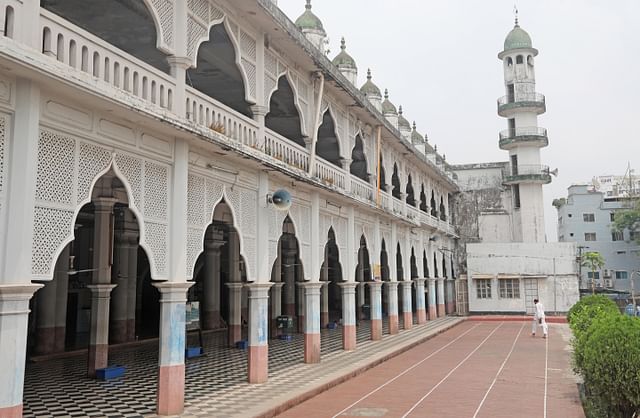The Andarqilla Jame Masjid built in Mughal style in Chittagong city is on a hilltop about 30 feet above the plain. On January 26, 1666, Chittagong came under the control of the Mughals. A year later the mosque was built
After the main gate of the mosque, if you go up the stairs, you will see the main building of the mosque built in an indescribably beautiful architecture, with which one of the proud history of the Mughal rulers of India is connected – the incident of Chittagong victory. It is three and a half centuries old Andarqilla Jame Masjid.
Modeled after Delhi’s Shahi Jame Masjid, this mosque in Chittagong city has an inscription in Persian in white letters carved on black stone at the entrance of the main building.
According to Bangladesh National Encyclopedia Banglapedia, the inscription mentions that Shaista Khan, Subadar of Bengal, built it in 1667 AD. However, it is believed that the real builder of this mosque was Shaista Khan’s elder son and Chittagong conqueror Umaid Khan. But his name is not mentioned in that inscription.
On the surface, it can be seen that the shopping mall built with rows of bookstores and various products has covered this mosque of beautiful architecture. Last Wednesday after Asr prayer congregation, the late afternoon sun was coming on the minaret of the mosque on a rainy afternoon. Musalli Md. sat on one side of the open square of the mosque and talked. With Abu Bakr Siddiqui. He lives on Chairman Road next door. He is a regular worshiper of this mosque for 30 years. He said, ‘It is a historical mosque. The main mosque room here is three hundred and fifty years old. Just sitting here gives peace of mind.’
Dr. ‘Andarqilla Shahi Jame Masjid’ written by Salim Jahangir, Abdul Haque Chowdhury’s ‘Bandar Sehar Chittagong’ book contains various information about Chittagong and Andarqilla Shahi Jame Masjid during the Mughal period. According to historians, Shaista Khan built Andarqilla Shahi Jame Masjid in 1667 AD on the orders of Emperor Aurangzeb to preserve the memory of Chittagong victory. However, his son Umed Khan led the entire process of Chittagong conquest and construction of the mosque.
This mosque is built in Mughal architecture on a hilltop about 30 feet above the plain. According to the design of the original mosque, it is 18 yards long, 7 and a half yards wide. The western wall of the mosque is made of terracotta bricks, while the other three walls are of stone. The roof consists of a large dome and two smaller domes. Of the four octagonal towers, the rear two still survive.

How was Chittagong then? It is known from the mentioned book ‘Port City of Chittagong’ that the reputation of Chittagong as a seaport has spread since the Middle Ages. However, before the Mughal conquest of Bengal, Chittagong was completely under the control of the Arakanese. During the reign of Emperor Jahangir, Subadar Islam Khan Chishti recovered the territory up to the Feni river from the Arakanese. Later some other subadars of Emperor Jahangir tried to capture Chittagong and failed.
Arakanese Mughals and Portuguese pirates along with them were plundering Bengal. Sometimes they also attacked Dhaka. Because of the pirates, the two banks of different rivers from Chittagong to Dhaka, i.e. the coastal districts, were almost depopulated. They also captured local people and sold them as slaves.
Taking charge of Bengal, Shaista Khan wanted to raid Chittagong as a pirate. In the last week of December 1665, he sent his son Umed Khan on the Chittagong conquest expedition. Ibn Hussain was then assigned as the naval commander. On January 26, 1666 Chittagong came under Mughal rule. This mosque was built a year later.
Since its construction, this mosque of Andarkilla has become the seat of the followers of Islam in Chittagong. But in 1761, Nawab Mir Qasim left the authority of Burdwan Medinipur district of West Bengal to the British.
After the British took control of Chittagong, Andarkilla Mosque was converted into an armory and stables. After that, the mosque remained under the British for about a hundred years. In 1853-54, some local residents appealed to the British government to return the mosque for Muslims to pray. On November 19, 1885, the British government allowed this mosque to be used again. After several renovations, the mosque now has a new look.
The large courtyard of the mosque, elaborate arches and domes will remind you of the Persian style of architecture. This mosque is also called ‘Stone Mosque’ as it is built using large stones like Delhi Jama Masjid.
Despite the various currents of history, the appeal of this mosque to people has never decreased. During the holy month of Ramadan, this mosque gathers fasting people. The mosque authorities organized Iftar for thousands of fasting people. Private assistant of the Khatib of the mosque. Hasan Murad said that at least two thousand worshipers and fasting people are breaking fast here every day during this Ramadan. By the end of Ramadan, this number will exceed five thousand.
Hasan Murad said that the iftar was organized on the personal initiative of the mosque’s Khatib Mohammad Anwar Hossain Taher Jaberi Al-Madani and under the supervision of the Islamic Foundation. However, the Musalli Parishad is in cooperation.
When asked how many people pray together, Hasan Murad said that thousands of people pray in this mosque every time. However, about seven thousand worshipers performed Friday prayers. About 30,000 Muslims pray in the mosque on the holy day of Jumatul Bidar in the month of Ramadan.